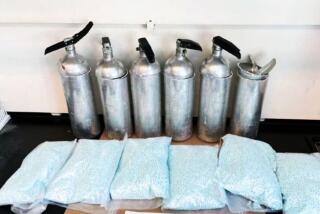Promises of cash, protection lure teens into smuggling drugs across border
They made a lot of promises.
They promised to pay the 16-year-old $1,000 for his first drug smuggling trip across the border. It was the kind of money that could help the teen’s single mom in Tijuana.
They promised that he wouldn’t get caught. As a student who crosses the border daily to go to high school in the U.S., he was virtually invisible.
They promised they would protect him if he got into trouble.
“But they weren’t protecting me,” the teen ultimately learned. “They were protecting their drugs.”
As he tells his story in Spanish in a video, his face in shadow so as to protect his identity, he begins to cry.
It’s not the acknowledgment that his own life has been tainted forever by his youthful mistake that makes him break down, but the shame that his mistake has affected his entire family.
His mother is now in debt with the government and his family is disqualified from SENTRI, government-issued border passes for low-risk crossers.
“My dreams went completely south,” he says. “I didn’t have plans to be here.”
The teen, along with the federal agents who produced the video, hope other students will learn from his mistake. The video is part of a presentation that authorities are working to revive in San Diego schools along the border to dissuade teens from falling prey to the lies of traffickers who try to recruit them as drug mules.
But hundreds of teens arrested at California border crossings over the past few years have already learned the hard way.
In fiscal 2017, Customs and Border Protection arrested 84 juveniles smuggling narcotics. That amount looks to stay on track this year, with 41 cases in the first six months. San Diego saw a large bump in teenage smugglers about 10 years ago, and then it was largely marijuana shifting to methamphetamine.
The stakes have risen these days with fentanyl — a drug so potent that absorption through the skin can kill. That hasn’t stopped traffickers from strapping it to the bodies of willing, naive teenagers.
“These cartels are like a business. So they are using every method they have. In this case they are just using kids because they can recruit them easily,” said Dave Shaw, special agent in charge of U.S. Homeland Security investigations in San Diego. “Then they just throw as many [juveniles] as they can at the border, hoping some just slide by.”
In one case, a student at Castle Park High School in Chula Vista told authorities that he’d smuggled drugs more than 20 times, sometimes twice in one day, being paid about $400 a trip. He was finally arrested in July 2017 at the Otay Mesa Port of Entry pedestrian crossing, with more than a kilogram of methamphetamine strapped to his legs, according to court records.
The teen also told investigators that he had several friends who also smuggled drugs. The kids most often being recruited for such work are frequent border crossers — typically Mexican citizens with border crossing cards who attend school in the U.S., often in districts near the border.
Some youths are swayed by peer pressure, having been recruited by friends, while others might have grown up in the drug culture and follow in an older sibling’s footsteps. The teen in the video was recruited by his cousin’s boyfriend.
For most, though, it’s the reward that makes it worthwhile, the cash for prom night or new shoes or concert tickets.
“They notice their family struggling and don’t want to ask them for money for their own things,” said HSI Special Agent Cynthia Estrella, who has helped educate students about the dangers of smuggling.
The prosecution of Phillip Junior Webb, 18, provides insight into how such a ring works.
Two juveniles who were arrested with meth strapped to their thighs in September told authorities that they were among many kids recruited by Webb, a fellow student at Castle Park who lived in Tijuana, according to the complaint. They said he offered them each $500 to smuggle drugs, and that they had done so successfully on prior occasions.
In many cases, records showed Webb had crossed the border within minutes of each of them, the complaint said.
Another student arrested with meth at the border a few weeks later had a similar story, that he’d been recruited by Webb for $300 to $400, with payment at least once being exchanged in the high school bathroom. The teen said he’d tried to get out of it at one point, but Webb encouraged him to continue.
Then in October, a teen was arrested at San Ysidro with more than 2 pounds of fentanyl strapped to his lower back. He said a female friend from Chula Vista High School had asked him to do it for a friend.
A few days after the request, he got a Facebook message from someone named “Anthony.”
The teen said he’d changed his mind but Anthony threatened him to go through with it, saying he knew where the teen lived, according to the complaint.
Investigators found a connection between the female friend and Webb, and also noted that Webb crossed at the same port of entry minutes apart from the teen, the complaint states.
Webb, who later transferred to MAAC Community Charter School in Chula Vista, was arrested in May when CBP officers found two unauthorized immigrants in the trunk of his Nissan Maxima at San Ysidro, according to the complaint.
The most common drugs seized from teen couriers are meth, heroin and cocaine. But fentanyl, a synthetic opioid that is up to 100 times as potent as heroin, has started to make appearances at the border. Cases against teens 17 and younger are prosecuted by the district attorney. Penalties can vary depending on the circumstances and the individual involved, but can include fines, weeks or months in Juvenile Hall — which the parents pay for — and rehabilitation programs.
Then there are the longer-lasting consequences that might be less obvious — but potentially more devastating — including the loss of their driver’s license, border crossing card, SENTRI pass, their parents’ SENTRI passes, as well as opportunities to obtain college loans, serve in the military or become a naturalized U.S. citizen.
“You have all these things to lose, but more significantly you’re going to impact your family,” said Assistant U.S. Atty. Sherri Hobson, who prosecutes drug smuggling cases.
For those 18 and over — many of whom are recruited in Tijuana nightclubs — it can mean a few years in prison and a felony on their record. Those cases are typically prosecuted by the U.S. attorney’s office.
Sentences for first-time offenders can vary depending on the type and amount of drug. A recent case against a man caught with 38 pounds of cocaine in his vehicle ended with a prison sentence of just over three years, for example.
Some young adults caught as drug mules in the past avoided prison time under a diversion program that was focused more on rehabilitation rather than punishment. Under the program, eligible defendants pleaded guilty to a felony but as long as they succeeded in school or work and completed other requirements, the felony would not be entered on their record.
But prosecutors this year stopped offering the diversion program for drug offenses.
When authorities noticed an uptick in teen smuggling around 2007 and 2008, law enforcement agencies got together and began putting on presentations at San Diego and Chula Vista high schools near the border to give them a glimpse of reality.
The presentation included graphic, bloody photos of victims of drug violence, a reminder of the brutality teens expose themselves to the deeper they get into the world of narcotics.
The teen in the video said he tried to get out but couldn’t — until he was arrested. Even now he said he worries his past will catch up with him. The traffickers made a copy of his ID before the first smuggling trip.
After several presentations, teen smuggling arrests at the California border dropped, and officials attribute much of the success to the outreach program.
Since 2009, customs and Homeland Security officials, prosecutors and San Diego police have visited more than 60 schools in the county under Project Crossing Guard.
The outreach has tapered off in recent years but is being revamped as arrests continue to climb and fentanyl continues to pose a serious threat.
kristina.davis@sduniontribune.com
More to Read
Start your day right
Sign up for Essential California for news, features and recommendations from the L.A. Times and beyond in your inbox six days a week.
You may occasionally receive promotional content from the Los Angeles Times.






